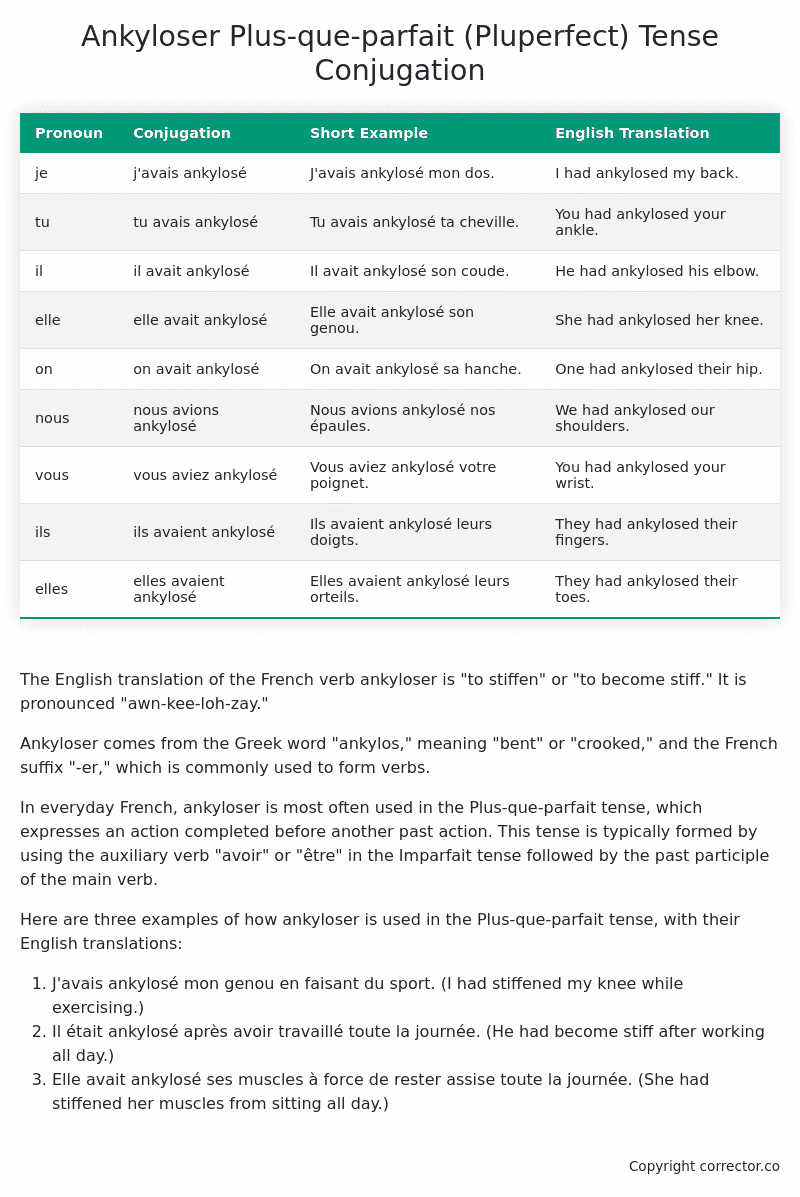Plus-que-parfait (Pluperfect) Tense Conjugation of the French Verb ankyloser
Introduction to the verb ankyloser
The English translation of the French verb ankyloser is “to stiffen” or “to become stiff.” It is pronounced “awn-kee-loh-zay.”
Ankyloser comes from the Greek word “ankylos,” meaning “bent” or “crooked,” and the French suffix “-er,” which is commonly used to form verbs.
In everyday French, ankyloser is most often used in the Plus-que-parfait tense, which expresses an action completed before another past action. This tense is typically formed by using the auxiliary verb “avoir” or “être” in the Imparfait tense followed by the past participle of the main verb.
Here are three examples of how ankyloser is used in the Plus-que-parfait tense, with their English translations:
- J’avais ankylosé mon genou en faisant du sport. (I had stiffened my knee while exercising.)
- Il était ankylosé après avoir travaillé toute la journée. (He had become stiff after working all day.)
- Elle avait ankylosé ses muscles à force de rester assise toute la journée. (She had stiffened her muscles from sitting all day.)
Table of the Plus-que-parfait (Pluperfect) Tense Conjugation of ankyloser
| Pronoun | Conjugation | Short Example | English Translation |
|---|---|---|---|
| je | j’avais ankylosé | J’avais ankylosé mon dos. | I had ankylosed my back. |
| tu | tu avais ankylosé | Tu avais ankylosé ta cheville. | You had ankylosed your ankle. |
| il | il avait ankylosé | Il avait ankylosé son coude. | He had ankylosed his elbow. |
| elle | elle avait ankylosé | Elle avait ankylosé son genou. | She had ankylosed her knee. |
| on | on avait ankylosé | On avait ankylosé sa hanche. | One had ankylosed their hip. |
| nous | nous avions ankylosé | Nous avions ankylosé nos épaules. | We had ankylosed our shoulders. |
| vous | vous aviez ankylosé | Vous aviez ankylosé votre poignet. | You had ankylosed your wrist. |
| ils | ils avaient ankylosé | Ils avaient ankylosé leurs doigts. | They had ankylosed their fingers. |
| elles | elles avaient ankylosé | Elles avaient ankylosé leurs orteils. | They had ankylosed their toes. |
Other Conjugations for Ankyloser.
Le Present (Present Tense) Conjugation of the French Verb ankyloser
Imparfait (Imperfect) Tense Conjugation of the French Verb ankyloser
Passé Simple (Simple Past) Tense Conjugation of the French Verb ankyloser
Passé Composé (Present Perfect) Tense Conjugation of the French Verb ankyloser
Futur Simple (Simple Future) Tense Conjugation of the French Verb ankyloser
Futur Proche (Near Future) Tense Conjugation of the French Verb ankyloser
Plus-que-parfait (Pluperfect) Tense Conjugation of the French Verb ankyloser (this article)
Passé Antérieur (Past Anterior) Tense Conjugation of the French Verb ankyloser
Futur Antérieur (Future Anterior) Tense Conjugation of the French Verb ankyloser
Subjonctif Présent (Subjunctive Present) Tense Conjugation of the French Verb ankyloser
Subjonctif Passé (Subjunctive Past) Tense Conjugation of the French Verb ankyloser
Subjonctif Imparfait (Subjunctive Imperfect) Tense Conjugation of the French Verb ankyloser
Subjonctif Plus-que-parfait (Subjunctive Pluperfect) Tense Conjugation of the French Verb ankyloser
Conditionnel Présent (Conditional Present) Tense Conjugation of the French Verb ankyloser
Conditionnel Passé (Conditional Past) Tense Conjugation of the French Verb ankyloser
L’impératif Présent (Imperative Present) Tense Conjugation of the French Verb ankyloser
L’infinitif Présent (Infinitive Present) Tense Conjugation of the French Verb ankyloser
Struggling with French verbs or the language in general? Why not use our free French Grammar Checker – no registration required!
Get a FREE Download Study Sheet of this Conjugation 🔥
Simply right click the image below, click “save image” and get your free reference for the ankyloser Plus-que-parfait tense conjugation!

Ankyloser – About the French Plus-que-parfait (Pluperfect) Tense
Tense Formation
Common everyday usage patterns
Sequencing of past events
Background information
Hypothetical or reported speech
Interactions with other tenses
Summary
I hope you enjoyed this article on the verb ankyloser. Still in a learning mood? Check out another TOTALLY random French verb conjugation!


